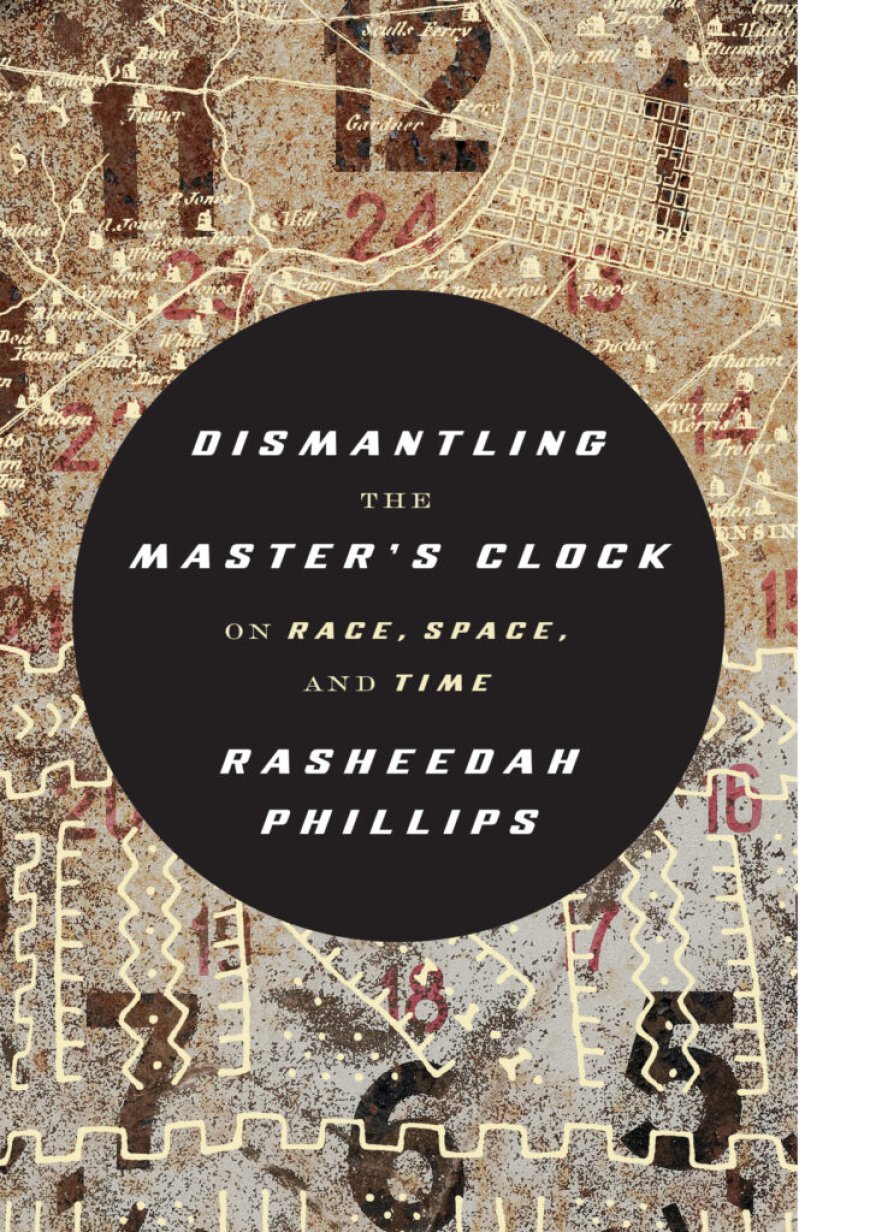Juneteenth
An excerpt from Dismantling the Master’s Clock by Rasheedah Phillips Juneteenth [is] widely celebrated as Freedom Day. The day commemorates June 19, 1865, when thousands of enslaved Africans held captive […] The post Juneteenth first appeared on Revolution by the Book.

 An excerpt from Dismantling the Master’s Clock by Rasheedah Phillips
An excerpt from Dismantling the Master’s Clock by Rasheedah Phillips
Juneteenth [is] widely celebrated as Freedom Day. The day commemorates June 19, 1865, when thousands of enslaved Africans held captive on plantations, farms, and other (stolen) land in Galveston, Texas, were finally emancipated two and a half years after January 1, 1863, the effective date of the Emancipation Proclamation and several months after the passage of the Thirteenth Amendment, intended to abolish slavery. This delay in emancipating enslaved people, despite the much-lauded legal proclamation, epitomizes the use of forced waiting as a means of temporal oppression on Black lives.
[On] June 19, 1865, in Galveston, Texas, the arrival of Union general Granger and his troops brought the overdue news that the Civil War had been over for more than two months and that enslaved people were in fact free, had been legally free for nearly three years. The 1863 Emancipation Proclamation had declared all slaves in Confederate-held territory to be free, including Texas.
However, enslavers had increasingly expanded their operations, beginning with the prohibition of the international slave trade in 1808. The domestic trade in the United States began to grow at that time, and Texas became a key destination in this internal market, due largely to its agricultural potential. Texas offered vast tracts of fertile land suitable for cotton, which was the most profitable cash crop of the time and heavily dependent on slave labor. The promise of high cotton profits incentivized the relocation of slaveholders to Texas. This agricultural expansion directly contributed to the increase in the enslaved population as slaveholders brought enslaved people with them or purchased more upon arrival to work the land. For instance, one document reveals that Wharton County, Texas, had a population that included 2,798 enslaved individuals by a certain period, illustrating the significant presence and reliance on enslaved labor in the state.
Texas was admitted to the Union as a slave state in 1845. This legal status made it an even more attractive destination for slaveholders from the older slave states. Later, Texas’s 1861 Confederate constitution prohibiting manumission would further contribute to the expansion of slavery operations, with enforcement nearly non-existent in the state due to the low Union army presence, in part because it had been the most remote state in the Confederacy. As the Civil War progressed, many slaveholders from states more directly impacted by the conflict sought to move their slaves and operations to Texas to avoid Union raids and the increasing likelihood of emancipation. This migration was a way for slaveholders to preserve their way of life and their economic investments in slavery.
For those enslaved in Texas, this period of waiting for freedom well beyond the policy date of January 1, 1863, created an information paradox where, though they were technically emancipated by the proclamation, enslaved people were technically “un-informed” of that emancipation by the Western understanding of the term (informed: 1540s, “current in information”), amplifying the power dynamics of their captivity.
But information still flowed, even under the crushing weight of slavery. There were many other means by which enslaved people collected and disseminated information among themselves and with distant communities that evaded the enslavers’ awareness. An excerpt from Elizabeth Ross Hite’s recollections of enslavement affirmed the existence of a clandestine information network: “News? We carried news by stealin’ off. Shucks, we knew ev’rything de master talked er bout. De house girl would tell us and would pass it er round.” Another account by a woman known as Aunt Aggy alluded to kinds of knowledge that evaded conventional knowledge. “You t’inks I’m mistaken, honey! But I knows t’ings dat de wite folks wid all dar larnin’ nebber fin’s out, an’ nebber sarches fo’ nudder.” These accounts reveal that being “informed” was a fraught status for enslaved people, laden with the psychological and emotional burdens of knowing freedom was possible yet out of reach and of knowing what is necessary to know to minimize harm, even before escape. Under slavery, being informed was not solely about knowing facts but about using this knowledge to gain agency and the capacity, ability, and power to act on that knowledge.
Even with modes of communication outlawed, such as writing, drumming, and their own languages, enslaved Black people invented other methods to share information via informal networks. Work songs and field songs on plantations frequently encoded spatial and temporal markers in their lyrics. In addition to serving as technologies to address physical isolation from each other, across different areas of large plantations or with nearby plantations, to synchronize communal work, and to make time pass, these songs, cries, calls, and hollers ultimately communicated layered temporal information across multiple scales of time, in the immediate (there, in the fields) and into the future (plans for meeting or routes of escape).
In the context of the oral traditions (songs, folk tales, and other spoken word) of Black people, sounds as distinct events creating their own disturbances in space-time gain added significance, where verbal articulation of a thought is inseparable from action, and where “ideas and words are seen as part of the same reality as the events to which they refer.” Levine gives the example of the Ashanti culture, where a person who speaks about having a dream of cheating on a partner may be punished to the same extent as a person who actually cheats. In these traditions, “the medium and the message intermesh in crucial ways” in which the “dynamic living quality of the spoken word was conducive to the sense of sacred space and time characteristics of Africans and Afro-Americans in slavery.” Singing or narrating the stories of the Bible and relating them orally to dream events and visions, for example, gave them a substance and dynamism that made the stories lifelike and gave the past a contemporaneity and significance absent from the European worldview, with its “highly segmented and compartmentalized sense of time” and its predominance of the written word on an “abstracted and detached printed page,” which diluted the notions of the past. Words are seen as having the ability to manifest or bring forth different times and realities in Afrodiasporic Traditions.
The delayed report to enslaved peoples in Texas of their legal freedom under the Emancipation Proclamation and of the Civil War’s end illustrates the power of the control of information. The awareness that enslavers had of these world-transformative events, systemically kept from those they exploited, through the suppression of literacy and communication, enabled their arbitrary manipulation of waiting time in order to eke out the maximum economic benefit. The time that elapsed between the events following the Emancipation Proclamation and the end of the Civil War, and the enforcement of the outcomes through the order delivered by General Granger were the result of the deliberate obstruction of information. Even when information couldn’t be manipulated and when their captives were aware, violence, force, and time itself were used to keep Black people enslaved.
Such management strategies by the slave-owning class undermined the capacity of the enslaved population to act collectively and decisively on their own behalf. This uniquely oppressive form of temporal subjugation shackled their claim to their freedom for more than two years. The strategic manipulation of waiting time by enslavers exposed the harsh reality that even awareness did not guarantee liberation. Freedom from bondage, and the end of white terrorism via slavery, was declared “fact” in a written document, which stated that “all persons held as slaves… shall be then, thenceforward, and forever free.”
However, Black people still had to wait for their actual freedom. They had to wait for the violence of war to end, wait for the master’s clock to strike midnight on January 1, wait for Lincoln to sign the proclamation, wait for the news to travel, wait for the sun to rise on June 19, wait to escape, wait for General Granger to leave Louisiana and march upon Galveston with his troops, then wait for him to read General Order No. 3. All of this before liberation could become “fact” and before freedom could become “truth.”
Enslaved Africans traversed time and space to liberate one another long before the date on the Emancipation Proclamation—during the time of the Civil War and after the time of so-called freedom. They ingeniously employed “waiting time” and communication in codes, symbols, songs, chants, and other means of obscuring the message—a social network relying on Afrodiasporic technologies their white colonialist human traffickers thought they had stripped them of. This network thrived on the principles of the Black folk narrative, carrying with them the weight of fact, history, and myth simultaneously. These narratives operated within a unique temporal dimension, one where the past, present, and future were interwoven into a collective memory and aspiration for true liberation.
The post Juneteenth first appeared on Revolution by the Book.
What's Your Reaction?























